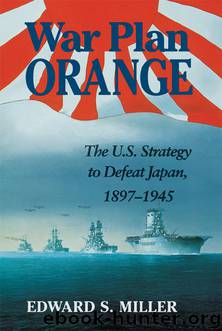War Plan Orange by Edward Miller

Author:Edward Miller [Miller, Edward S.]
Format: epub
ISBN: 9781612511467
Publisher: Naval Institute Press
MAP 22.2
Rainbow Two’s revival of a Through Ticket cruise to a doomed port in the Orient was out of touch with reality. The truth was driven home by the German blitzkrieg of May 1940 that overran Holland and France and threatened Britain’s survival, nullifying fantasies of all-out Allied efforts in the Pacific. The plight of the orphaned colonies in Asia undermined the core assumption of a dependable Allied resistance pending Blue’s arrival. During the summer the planners, deluged with emergency projects for defending the Atlantic and South America, shelved the plan.50 In October Richardson urged the department to scrap it altogether.51 Turner and Stark heartily agreed. Rainbow Two thereby expired, never having evolved beyond the drafting stage. The Joint Board never acted on it, and no army or navy supporting plans were outlined.
The last plan to direct the main U.S. war effort against Japan, Rainbow Three, was first explored in April 1940, when the Joint Board elevated its priority as it became evident that the Allies could not spare much for the Pacific. The plan assumed that the friendly powers would be able to shield the Atlantic and enable the United States to dedicate itself to common interests in the western Pacific. But unlike Rainbow Two, the country would get little help in that distant theater. The JPC’s outlines presumed that in response to a Japanese onslaught against Malaysia the United States would first secure the eastern Pacific, then extend its control westward “as rapidly as circumstances permit” with the help of whatever aid the Allies could render. But the dispatch of maximum power directly to Asia would be “inadvisable or unnecessary” for both military and public opinion reasons.52
Rainbow Three was a daunting strategic conception, neither a brazen thrust like Rainbow Two nor a prudent crawl like Plan Orange. It was a hybrid with the worst features of both. The navy, perhaps for that reason, left the drafting to the Army War Plans Division, an odd venue for a maritime plan. For lack of a better idea, Colonel McNarney hypothesized an opening scene like that in Rainbow Two: the Philippines and northern Indies lost, Orange closing on Singapore, heavy casualties to both sides yet, miraculously, the “weak” Allies holding the Malay Barrier. The Blue objective would still be to deny Orange the oil of Borneo, although without the “great advantage” of a direct rescue expedition. Instead, the fleet and a full army corps would concentrate gradually at Hawaii. In considering a movement “well to the westward”—although not as far as Singapore or Java—McNarney found himself ensnarled in old thruster-versus-cautionary trade-offs of speed, route, and destination. Sketchy intermediate objectives, barely mentioned, included Rabaul, the Celebes, and the Palaus (Chapter 21).53 He had not progressed far when the Allied collapse in Europe pushed the plan into limbo.
In the fall of 1940 the JPC took a brief second look at Rainbow Three and proposed to shrivel it to a frail script of hemisphere defense and prowlings against trade rather akin to Rainbow Four with token support of the British and Dutch in Malaysia.
Download
This site does not store any files on its server. We only index and link to content provided by other sites. Please contact the content providers to delete copyright contents if any and email us, we'll remove relevant links or contents immediately.
| Africa | Americas |
| Arctic & Antarctica | Asia |
| Australia & Oceania | Europe |
| Middle East | Russia |
| United States | World |
| Ancient Civilizations | Military |
| Historical Study & Educational Resources |
The Radium Girls by Kate Moore(11616)
100 Deadly Skills by Clint Emerson(4683)
The Templars by Dan Jones(4556)
Rise and Kill First by Ronen Bergman(4542)
The Doomsday Machine by Daniel Ellsberg(4241)
The Rape of Nanking by Iris Chang(4019)
Killing England by Bill O'Reilly(3896)
Hitler in Los Angeles by Steven J. Ross(3796)
Stalin by Stephen Kotkin(3721)
12 Strong by Doug Stanton(3418)
Hitler's Monsters by Eric Kurlander(3161)
Blood and Sand by Alex Von Tunzelmann(3055)
Darkest Hour by Anthony McCarten(3017)
The Code Book by Simon Singh(2854)
The Art of War Visualized by Jessica Hagy(2835)
Hitler's Flying Saucers: A Guide to German Flying Discs of the Second World War by Stevens Henry(2621)
Babylon's Ark by Lawrence Anthony(2427)
The Second World Wars by Victor Davis Hanson(2419)
Tobruk by Peter Fitzsimons(2373)
